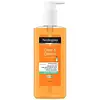What's inside
What's inside
 Key Ingredients
Key Ingredients

 Benefits
Benefits

 Concerns
Concerns

 Ingredients Side-by-side
Ingredients Side-by-side

Aloe Barbadensis Leaf Juice
Skin ConditioningSqualane
EmollientCoconut Acid
CleansingCandelilla Cera
EmollientCaffeine
Skin ConditioningAllantoin
Skin ConditioningCalophyllum Inophyllum Seed Oil
AntimicrobialZinc PCA
HumectantTocopherol
AntioxidantPinus Pinaster Leaf Extract
Skin ConditioningAvena Sativa Kernel Extract
AbrasiveAvenanthramides
AntioxidantHyaluronic Acid
HumectantCeramide As
Skin ConditioningBeta-Glucan
Skin ConditioningCoconut Oil Decyl Esters
Skin ConditioningHelianthus Annuus Seed Oil
EmollientBeta-Carotene
Skin ConditioningParfum
MaskingLecithin
EmollientAnthemis Nobilis Flower Oil
MaskingGrass-Hay Herb Extract
PerfumingCI 75810
Cosmetic ColorantAloe Barbadensis Leaf Juice, Squalane, Coconut Acid, Candelilla Cera, Caffeine, Allantoin, Calophyllum Inophyllum Seed Oil, Zinc PCA, Tocopherol, Pinus Pinaster Leaf Extract, Avena Sativa Kernel Extract, Avenanthramides, Hyaluronic Acid, Ceramide As, Beta-Glucan, Coconut Oil Decyl Esters, Helianthus Annuus Seed Oil, Beta-Carotene, Parfum, Lecithin, Anthemis Nobilis Flower Oil, Grass-Hay Herb Extract, CI 75810
Water
Skin ConditioningCocamidopropyl Hydroxysultaine
CleansingSodium Methyl Cocoyl Taurate
CleansingGlycerin
HumectantSalicylic Acid
MaskingSodium Hydrolyzed Potato Starch Dodecenylsuccinate
C12-15 Alkyl Lactate
EmollientPanthenol
Skin ConditioningCocamidopropyl Pg-Dimonium Chloride Phosphate
Disodium Tetrapropenyl Succinate
PEG-120 Methyl Glucose Dioleate
EmulsifyingSodium Chloride
MaskingDisodium EDTA
Citric Acid
BufferingSodium Hydroxide
BufferingTocopherol
AntioxidantBenzalkonium Chloride
AntimicrobialParfum
MaskingWater, Cocamidopropyl Hydroxysultaine, Sodium Methyl Cocoyl Taurate, Glycerin, Salicylic Acid, Sodium Hydrolyzed Potato Starch Dodecenylsuccinate, C12-15 Alkyl Lactate, Panthenol, Cocamidopropyl Pg-Dimonium Chloride Phosphate, Disodium Tetrapropenyl Succinate, PEG-120 Methyl Glucose Dioleate, Sodium Chloride, Disodium EDTA, Citric Acid, Sodium Hydroxide, Tocopherol, Benzalkonium Chloride, Parfum
 Reviews
Reviews

Ingredients Explained
These ingredients are found in both products.
Ingredients higher up in an ingredient list are typically present in a larger amount.
Parfum is a catch-all term for an ingredient or more that is used to give a scent to products.
Also called "fragrance", this ingredient can be a blend of hundreds of chemicals or plant oils. This means every product with "fragrance" or "parfum" in the ingredients list is a different mixture.
For instance, Habanolide is a proprietary trade name for a specific aroma chemical. When used as a fragrance ingredient in cosmetics, most aroma chemicals fall under the broad labeling category of “FRAGRANCE” or “PARFUM” according to EU and US regulations.
The term 'parfum' or 'fragrance' is not regulated in many countries. In many cases, it is up to the brand to define this term.
For instance, many brands choose to label themselves as "fragrance-free" because they are not using synthetic fragrances. However, their products may still contain ingredients such as essential oils that are considered a fragrance by INCI standards.
One example is Calendula flower extract. Calendula is an essential oil that still imparts a scent or 'fragrance'.
Depending on the blend, the ingredients in the mixture can cause allergies and sensitivities on the skin. Some ingredients that are known EU allergens include linalool and citronellol.
Parfum can also be used to mask or cover an unpleasant scent.
The bottom line is: not all fragrances/parfum/ingredients are created equally. If you are worried about fragrances, we recommend taking a closer look at an ingredient. And of course, we always recommend speaking with a professional.
Learn more about ParfumTocopherol (also known as Vitamin E) is a common antioxidant used to help protect the skin from free-radicals and strengthen the skin barrier. It's also fat soluble - this means our skin is great at absorbing it.
Vitamin E also helps keep your natural skin lipids healthy. Your lipid skin barrier naturally consists of lipids, ceramides, and fatty acids. Vitamin E offers extra protection for your skin’s lipid barrier, keeping your skin healthy and nourished.
Another benefit is a bit of UV protection. Vitamin E helps reduce the damage caused by UVB rays. (It should not replace your sunscreen). Combining it with Vitamin C can decrease sunburned cells and hyperpigmentation after UV exposure.
You might have noticed Vitamin E + C often paired together. This is because it is great at stabilizing Vitamin C. Using the two together helps increase the effectiveness of both ingredients.
There are often claims that Vitamin E can reduce/prevent scarring, but these claims haven't been confirmed by scientific research.
Learn more about Tocopherol